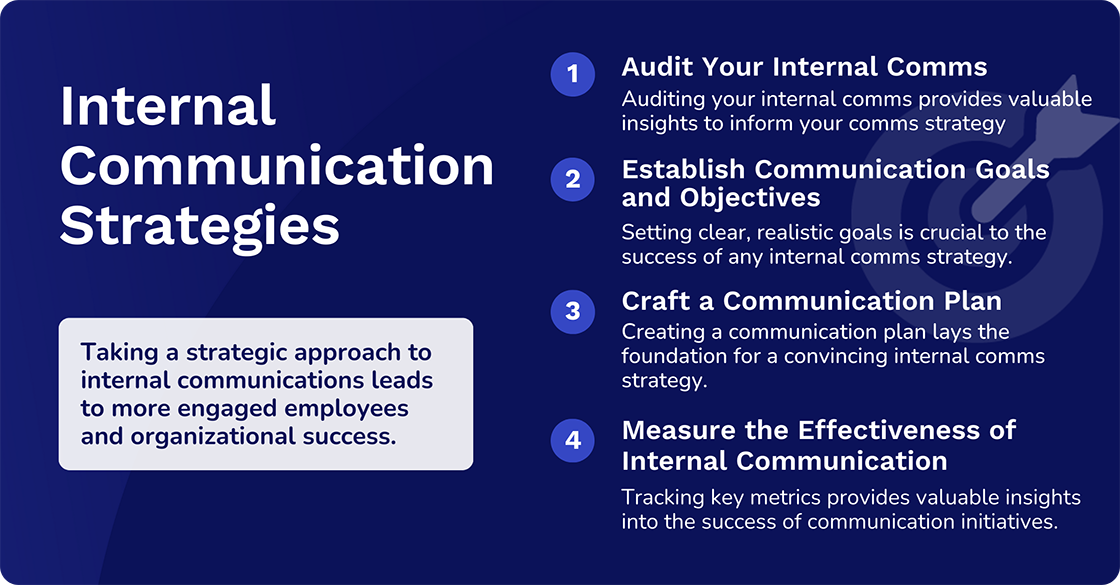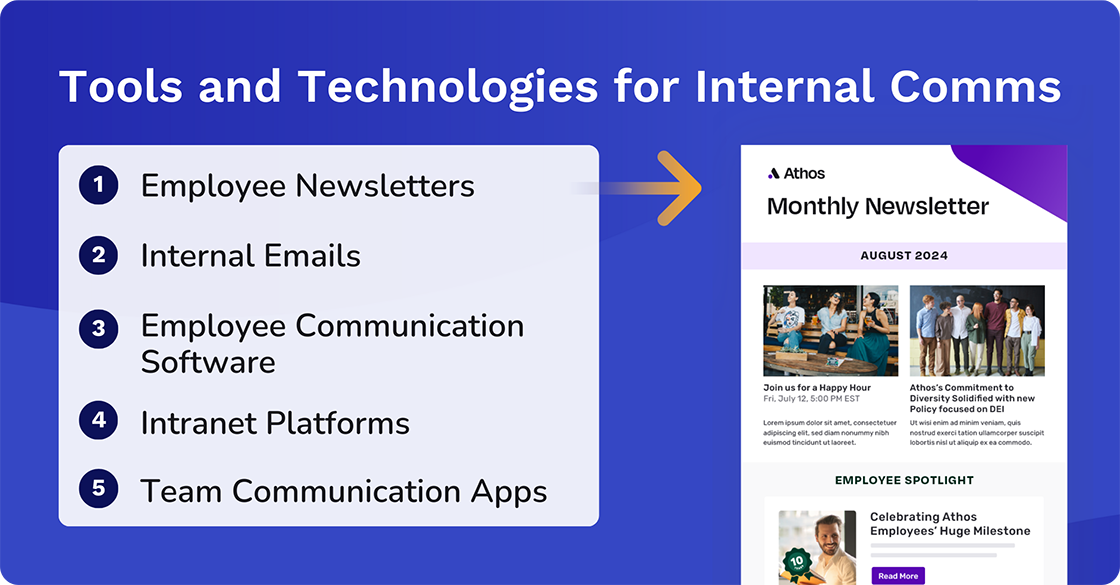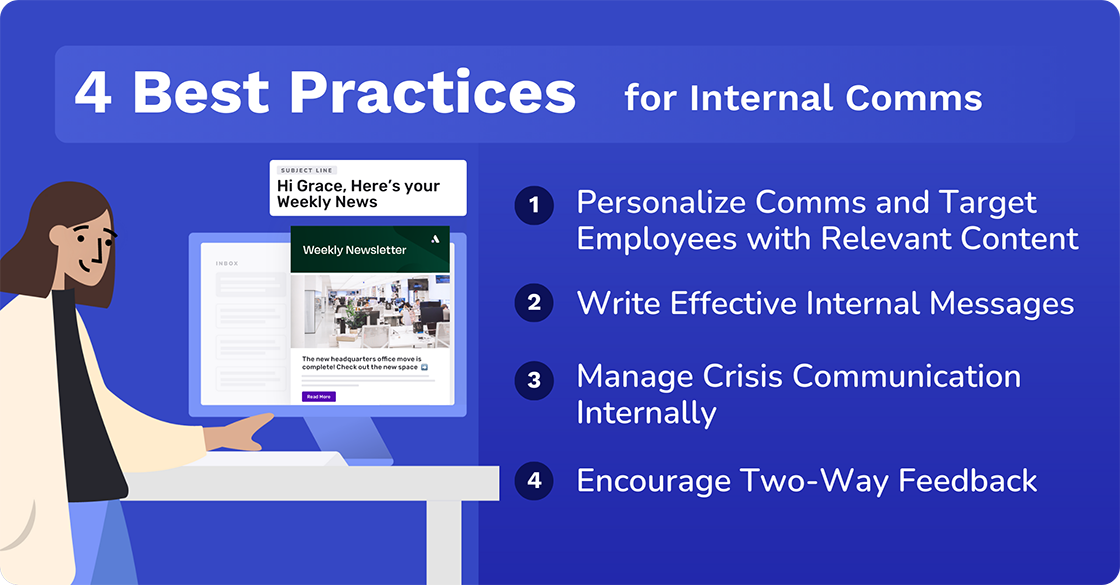Our comprehensive guide examines the intricate world of internal communications, whether you are a seasoned internal communicator or just getting started.

.webp)
Effective internal communication is the backbone of every successful organization. Learn the ins and outs of internal communications with our research-backed white paper.
Access NowIn today’s rapidly changing and interconnected business landscape, internal communications are more crucial than ever before. By fostering open and transparent dialogue, organizations can not only disseminate critical information but also cultivate a unified and engaged workforce. Effective internal communication builds trust, promotes a culture of transparency, and empowers employees to thrive.
However, despite its importance, many companies face challenges in developing and implementing effective internal communication strategies. By prioritizing employee communication, organizations can unlock the full potential of their workforce and drive business success.”
In an August 2024 Gallup poll, only 27% of employees strongly agreed that their immediate supervisor keeps them informed about organizational matters, highlighting a significant gap in leadership communication effectiveness. The poll shows that employee trust in leadership has dropped, which has a direct impact on performance.

It’s all about communication. However, even when there is communication between leadership and employees, it isn’t always effective, as Grammarly’s The 2024 State of Business Communication shows.
“Businesses run on communication. When communication is effective, it creates value and fuels success—but when it’s not, businesses face avoidable costs in the form of lost productivity, declining morale, customer churn, and eroded brand reputation.”
Grammarly
Ultimately, they predict that “Which way each business tips will depend on how well it scales effective communication and harnesses the power of AI.”
Undoubtedly, the evolution of internal communications is complex and challenging, but critically important to organizations to ensure that they thrive in the modern workplace. With all this in mind, our comprehensive guide examines the intricate world of internal communications. Whether you are a seasoned internal communicator or just getting started, it will provide you with a wealth of knowledge, insights, and information about best practices to help you navigate and master the complex field of employee communication that lies ahead.
Internal communications, often abbreviated as internal comms, is the nexus of corporate communication. It is a process that involves sharing information, ideas, and feedback within an organization. This helps to foster collaboration, engagement, and alignment with company goals.
A good internal communication strategy serves as the backbone for creating and disseminating messages and campaigns on behalf of management, promoting two-way employee communications, and honing the communication abilities of the organization. While traditionally it may have involved company newsletters or meetings, today’s internal communications strategies encompass a broader range of tools and initiatives. Internal communicators now take advantage of project management systems, social media, and instant messaging tools.
When efficiently executed, internal communications plays a vital role by:
Ultimately, it can generate a synergy that aligns everyone with the company’s overall objectives.
Effective internal communication is pivotal in creating a motivated, informed, and engaged workforce. These are benefits that hold even more substance for remote and hybrid workers — a sizable chunk of the modern economy’s employees.
However, many organizations face challenges that render their internal communications ineffective. Common issues include misalignment between leaders and employees, lack of context, incomplete data due to inadequate tracking, and inaccessible insights. These communication breakdowns can have significant financial implications. For instance, the Grammarly report, developed in collaboration with The Harris Poll, emphasizes that ineffective communication costs U.S. businesses up to $1.2 trillion annually.
Gallup’s State of the Global Workplace 2024 Report reveals that Gallup estimates low employee engagement costs the global economy US$8.9 trillion, or 9% of global GDP.
Addressing the challenges that negatively impact internal communication is crucial for fostering a cohesive and efficient work environment, ultimately contributing to the organization’s success.
The reality is that when internal communications are inadequate, employees often feel uncertain, inefficient, and isolated from corporate objectives. For this reason, it’s crucial for any organization to establish an internal communications strategy that prioritizes trust and the engagement of employees.
Implementing internal communications initiatives like regular feedback, sharing of information, and open communication avenues can foster greater co-worker trust, increase employee engagement, and ultimately achieve the organization’s overall business objectives. Ultimately, the importance of staff communication is about facilitating meaningful dialogue.
Internal communications can take many forms, including formal and informal methods, as well as typical top-down and bottom-up channels. Understanding these different types of communication and selecting the most appropriate channels for specific messages ensures that information is effectively shared and understood by employees at all levels. Let’s look at a few less obvious examples.
Turn your internal communications strategy around today

Despite the best efforts of organizations and internal communicators, challenges and obstacles can arise in the pursuit of effective internal communication. By recognizing these, and exploring successful solutions to address them, organizations can continually refine their communication strategies, adapt to changing circumstances, and ensure the ongoing success of their internal communication efforts.
Whether they’re working in the office or remotely, ensuring employees feel heard, informed, and part of the company initiative is vital for success.
Some common internal communication challenges include information overload, lack of clarity in messaging, inconsistent communication, and difficulty in reaching remote or distributed employees.
The reality is that when employees are engaged and interested in reading the communications sent to them, they become more closely aligned with the broader goals of the organization. However, as Gallup has found over and over again, employee engagement in the US continues to drop. Jim Harter, Gallup, chief scientist of Workplace Management and Wellbeing, wrote in April 2024 that 4.8 million fewer US employees were engaged in early 2024. In June 2024, he wrote that it was prudent to engage your workforce by empowering your management first! That takes us back to the leadership issues we mentioned earlier.

Implementing best practices, such as clear and concise messaging, using appropriate communication channels, and leveraging technology tools, effectively overcomes these challenges and creates a more cohesive and engaged workforce.
Learning from companies with successful internal communication strategies can offer valuable insights. Case studies provide real-world examples of how businesses use their internal communication tools and strategies to improve employee engagement, meet business goals, and foster a positive company culture. These stories can serve as inspiration and best practice guidelines for others.
For example, Paycor’s case study is impressive. This HR software company had all its employees working remotely, from home, soon after COVID-19 hit. It was a challenge they embraced, and the result was that they expanded and transitioned into the first fully virtual-first national technology company. Key to their success was the Cerkl Broadcast platform that enabled them to reorganize their communications strategy using their existing Intranet. Open rates, click-through rates, and employee satisfaction and engagement improved. The rest is history.
When Church & Dwight, a company recognized globally for its household and personal care products, reached out to Cerkl, one of their primary challenges was an inability to effectively engage their workforce. The Church & Dwight case study shows the positive impact of creating a seamless communication experience for employees that enhances engagement. The platform’s advanced features have also enabled the company to make vital data-driven decisions.
https://vimeo.com/725781394
Paycor Success Story
Developing a successful internal communication strategy is a multifaceted process that involves crafting a plan, establishing goals and objectives, and measuring the effectiveness of communication efforts. Taking a strategic approach to internal communications ensures that information is shared in a timely, consistent, and engaging manner. Ultimately, this leads to more engaged employees and contributes to overall organizational success.
An internal communication audit is a comprehensive assessment of how well your organization engages and communicates with its employees. As a crucial element of your overall internal communications plan, it provides valuable insights that inform and shape your internal communications strategy. The goal of an audit is to optimize internal communications to drive business outcomes, improve employee experience, and enhance organizational performance.
Setting clear, realistic goals and objectives is crucial to the success of any internal communication strategy. Adopting the SMART logic is an excellent approach. By being Specific, Measurable, Achievable, Relevant, and Time-bound ensures that communication goals are focused, actionable, and aligned with the overall business objectives.
A well-crafted communication plan serves as the foundation for a convincing internal communications strategy.
Creating the plan involves defining the goals, identifying key messages, selecting communication channels, and establishing an approval process. A good communication plan also includes provisions for regular updates, revisions, and feedback systems to track progress and improve the effectiveness of internal communications.
Evaluating the effectiveness of internal communication efforts is essential for identifying what works, what needs improvement, and how to make informed adjustments to the communication strategy. Tracking key metrics, such as employee engagement, response rates, and feedback, provides valuable insights into the success of communication initiatives and supports data-driven decisions to enhance strategies moving forward.
The methodology might involve surveys to gather employee feedback, tracking metrics like open, click-through, and read rates of digital internal communications, and tracking participation in company initiatives, and more.

There are various tools and technologies available in the modern work environment to support and enhance internal communication efforts. They include:
These options allow organizations to ensure that information is effectively shared and understood by employees at all levels. So, let’s explore some of the most popular and effective internal communication tools used today.
Employee newsletters have metamorphosed from printed documents to an automated, dynamic medium that improves employee engagement and the employee experience. Today, digital employee newsletters offer a range of benefits, including increased accessibility, personalized content, and real-time updates. By leveraging automation and analytics, organizations can tailor their newsletters to specific audience segments, track engagement, and measure the impact on employee sentiment and behavior.
By adopting a modern employee newsletter strategy, organizations can foster a more informed, engaged, and connected workforce.
Email and messaging systems are widely used in internal communication. They provide a fast and efficient means of sharing information, documents, and files with colleagues. While these tools can be highly effective, they also come with certain limitations and challenges. These include the potential for miscommunication, communication overload, and decreased productivity due to excessive use.
To overcome these challenges it makes sense to consider combining email and instant messaging with video conferencing and collaboration tools. This will optimize communication and ensure that employees receive the information they need in a timely and efficient manner.
Software used to engage employees is designed to help organizations enhance engagement with their personnel through various features, including:
Utilizing these platforms improves internal communications, fosters a stronger sense of connection and belonging among team members. Ultimately, it increases employee satisfaction and productivity.
Turn your internal communications strategy around today

Intranet platforms are a powerful tool for internal communication, providing a centralized, accessible space for employees to access important company information, news, and resources. Intranet can help improve collaboration, streamline communication, and keep employees informed and engaged. This can make them an essential component of any internal communications strategy.
Some popular intranet platforms include Jive, Microsoft SharePoint, and Workplace. When selecting an intranet platform, consider factors like business goals, strategic vision, hosting options, features and functionality, scalability, data storage, budget, user experience, integration capabilities, and support and training.
Team communication apps are designed to facilitate real-time communication and collaboration. They provide a centralized platform for teams to share information, discuss projects, and work together more efficiently. By using team communication apps, organizations can improve communication, increase productivity, and enhance collaboration. Popular options include Microsoft Teams, Google Workspace (formerly G Suite), Discord, Flock, Slack, and Slack alternatives.
When selecting a team communication app, consider factors like:
By choosing the right team communication app, organizations can improve internal communication, enhance collaboration, and drive business results.

To ensure internal communications are effective, organizations should follow best practices. These include writing effective messages, managing crisis communications internally, and encouraging two-way feedback from employees.
Personalizing and targeting internal communications is crucial to engaging employees and driving business outcomes. By leveraging employee data and analytics, organizations can tailor their messages, content, and channels to specific audience segments, increasing the relevance and impact of their communications. This involves identifying and understanding different employee personas, interests, and preferences, and using this information to create targeted campaigns.
A clear and concise message is the secret to good internal communications. The content should be relevant, timely, and in a conversational tone to promote engagement. Moreover, the use of a company newsletter to share such information makes the message unified, ensuring everyone is on the same page.
Internal communications play a critical role in crisis management, helping organizations respond effectively and efficiently to unexpected events and challenges. Having a well-defined internal communications strategy in place during times of crisis minimizes the negative impact, provides guidance on how to move forward, and maintains trust with employees.
Effective crisis communication involves being transparent, timely, and empathetic, ensuring that employees receive accurate information and feel supported throughout the crisis.
Two-way feedback is essential for maintaining a positive employee experience. Internal communications create an opportunity for employees to voice their ideas, concerns, or suggestions. A range of communication channels including surveys, town halls, or suggestion boxes can facilitate exchange, supporting a culture of transparency and openness.

We mentioned Grammarly’s The 2024 State of Business Communication earlier and the fact that it’s vital to embrace AI. Just about every report produced in the past year or so embraces this perspective, and the pressure is on.
Gallagher’s 2025 State of the Sector Employee Communications Report highlights AI, emphasizing its importance, but drawing attention to the fact that “implementation has been slow.”
“While the revolution may not happen within the next year, an AI-driven market shift is upon us.”
Ben Reynolds, Managing Director, Global Communication Consulting at Gallagher.
Additionally, the report points out that despite a focus on hyper-personalization, the foundations for this technology are not in place either.
Let’s dig a little deeper.
Tarek Kamil, Founder and CEO of Cerkl, recently co-hosted a webinar with Preston Lewis, Founder and CEO of Intactic, How AI Makes Internal Communications More Human. Their conversation shows very clearly how AI technology saves time, money, and enables us to get on with the work that matters. AI can enable internal communicators to improve their function — if they take advantage of it, they certainly won’t lose their jobs! Their message was loud and clear. AI is here to stay, and internal communicators need to harness its power to help them do their jobs better.
“AI technology saves time. It saves time on the employee experience, the end-user experience. Very importantly, it saves time for communication teams. And when we talk about how AI enables us to make communications more human, we have to understand how we can save time to ultimately make more time and create more space for us to focus on the right work.”
Preston Lewis
Tarek also highlights how companies like Amazon and Netflix have been personalizing customer experiences for years. This, he explains, is exactly what Cerkl Broadcast does. And the hyper-personalized experience that Broadcast delivers is becoming increasingly sophisticated, with more insights and analytics, as well as more available channels.
The opportunities, he says, are to be able to use different languages, different formats, and different channels, and to “let the tech do its job” when we deliver messages to employees.
Effective internal communication is vital for organizations to foster employee engagement, enhance productivity, and achieve overall success. By understanding the key principles of internal communication, the role of internal communicators, and the various types of communication channels, you can develop and implement successful strategies that meet the needs of your workforce.
As the remote work era continues to evolve, organizations must adapt their internal communication strategies. This ensures that employees remain connected, informed, and aligned with company goals, regardless of their location. By embracing best practices and leveraging the latest tools and technologies, organizations can create a more cohesive, engaged, and high-performing workforce.
Cerkl Broadcast recognizes the need for a holistic approach to employee engagement and internal communications. The Broadcast platform is structured for you to align employees with organizational goals. For example, it delivers personalized emails and intranet content to engage and inform employees. It also enables you to create unique newsletter templates and garner feedback from communications.
The platform’s top features include Email Blasts or Eblasts. These save time and effort, as do Broadcast News Digests that enable you to send regularly scheduled emails including content individual employees find interesting directly to their inbox via Eblasts. Personalization of both Eblasts and News Digests increases employee engagement, which, in turn increases productivity.
Another huge advantage is that you will also receive real-time analytics on how your employees interact with the posts that you share. These include open rates, click rates, and engagement scores. The insights these analytics provide will enable you to assess what content resonates best with your workforce. This eliminates the guessing game and will allow you to make data-driven decisions.
How are your internal communications performing? Chances are you won’t be able to identify success rates or problems. Don’t worry. We’ve got the answer for you. Cerkl Broadcast’s free strategic internal communications white paper will help you improve your internal comms strategy quickly and efficiently.
What are you waiting for? Download it now.

Turn your internal communications strategy around today
What is internal communication and examples? Internal communication is the process of sharing information within an organization, using various channels like staff newsletters, emails, intranet, and suitable apps. It helps organizations effectively share important information with their employees when and where it's needed. Compelling internal communications are essential for any organization.
What are the 8 types of internal communication? The 8 most cited types of internal communication include top-down communication, change communication, crisis communication, information communication, bottom-up communication, peer communication, campaign communication, and culture communication.
What are the key principles of internal communication? Transparency, consistency, clarity, and an employee-centric approach are considered to be the key principles of effective internal communication.
How can organizations adapt their internal communication strategies for remote and hybrid workforces? Organizations can successfully adapt their internal communication strategies for remote and hybrid workforces by leveraging technology tools, ensuring information accessibility, and fostering a sense of connection and belonging.
What are some effective tools and technologies for internal communication? Intranet platforms, employee engagement software, email, messaging systems, and social media are all effective tools and technologies for internal communication. They all allow teams to collaborate effectively and efficiently and should be used together for ultimate effectiveness.

Turn your internal communications strategy around today